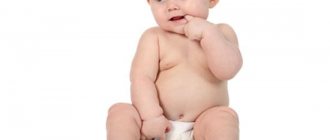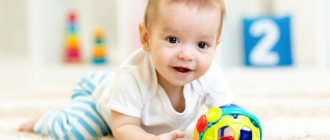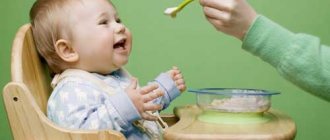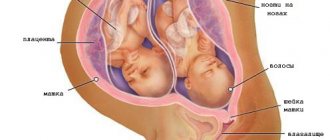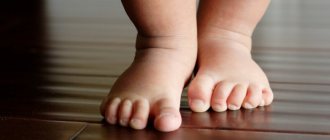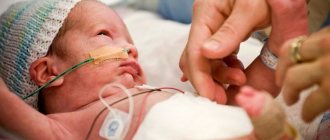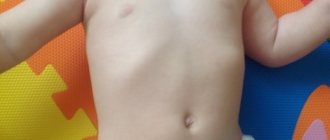Most kids are tireless explorers
Where do they get so much energy? Babies continue to learn to crawl and expand their knowledge of the world around them. Muscle tone improves, the child’s movements become even more coordinated.
Some babies crawl forward and around their axis, like seals, on their stomachs.
Others begin to crawl “on all fours,” leaning on their hands and knees. Both methods of movement allow the baby to independently, without the help of an adult, move from one room to another, and overcome various obstacles (thresholds, objects).
Held by the hands, the child stands well on even soles, bearing the entire weight of the body on his feet. Feeling support, the baby learns to lift his leg. The first steps are just around the corner.
In a sitting position, the baby feels very confident - he maintains his balance well, even if he holds objects in his hands. Be very careful, do not leave your baby unattended if he is sitting on the sofa or in an armchair.
Confidence in his own abilities pushes the baby to master new movements - he learns to get off and climb on the sofa, climb stairs. These motor skills allow the child to look at surrounding objects from a new perspective, at different distances.
Physiology
What has the child learned by the 10th month of life?
- The child’s physical activity is at its best; he does not sit still for a minute. In this regard, weight gain is no longer as active as in the first six months. The baby moves, actively consumes calories and burns them very quickly.
- Coordination of movements is also improved. The baby crawls maneuverably throughout the apartment, exploring the world around him and not giving the nannies a moment's rest.
- The child’s fingers have learned dexterity: now objects can be grasped not with the whole palm, but neatly and elegantly. You can also unclench your fist, if you are tired of the toy, throw it on the floor.
- By 10 months, the baby manages to acquire an average of four beautiful incisors. If teeth have not appeared by this age, consult your pediatrician for advice.
Mental development
Kids begin to navigate everyday situations, recognize some sounds and correlate them with the sound source - they turn their heads towards the ringing phone or the sound of a door opening slightly, look for familiar objects and people with their eyes if an adult is talking about them.
The baby likes to explore the contents of cabinets, especially kitchen cabinets - he happily takes pots, pans, bowls from there and scatters them on the floor.
These games with household utensils continue for a long time, sometimes up to two years. The child does not yet take the adult’s prohibitions not to touch “dangerous” objects (forks, glassware) seriously. Remember this and try to make the space around the baby safe in advance.
Physical development of the baby - height and weight of the child at 10 months
Physical parameters of a child’s development at 10 months are within the limits:
| BOYS | GIRLS | |
| Height, cm | 68,1-79 | 67,7-78,1 |
| Weight, kg | 8,0-11,8 | 7,9-10,9 |
| Head circumference, cm | 44,0-49,6 | 42,8-49,2 |
| Chest circumference, cm | 44,3-52,8 | 44,3-52,0 |
By 10 months, most babies have grown up to 6 teeth - 2 lower middle, 2 upper middle and 2 upper lateral incisors. Children at this age grow by 1-1.5 cm within a month and gain 400-500 grams in weight, and overly active children - no more than 300 grams.
Children's games become longer and more varied
“Favorite” soft toys and dolls appear. A child gets angry and shows his dissatisfaction if an object (toy) that he likes is taken away from him. At the request of an adult, children can give a toy and show its details. Children love playing with objects that can be taken out of small boxes, bags, and transparent jars.
Start leaving small cardboard boxes with toys and objects in different places in the apartment that the baby will take out and examine. The baby gets great pleasure from playing with adults. The baby understands the rules of the game and laughs loudly if an adult hides under a scarf or behind furniture.
Remember the traditional Russian nursery rhymes: “Guli-Guli”, “Soroka-Soroka”, “Horned Goat”. The emotional intonation and simple rhythm of the rhyme help the baby remember and perform simple movements that accompany reading the nursery rhyme - he begins to clap his hands, bend his fingers, put his hands on his head. Such games help to remember the meaning of words denoting objects and actions.
Child plays: from birth to one year
Authors : Marilyn Segal
A CHILD'S WORLD Ten months is a very interesting age. Watching your baby is fun and pleasant. He is so selflessly immersed in the game that he almost does not notice the spectators admiring him. The ten-month-old's main concern seems to be whether one object can somehow be used to do something with another. Of course, the child asks this question with actions rather than words. While playing with two objects at the same time, the baby comes up with the idea of turning one of the objects into an instrument. Let's give the most common examples: a child takes a spoon and carefully scatters peas around his high chair or beats a tea strainer on a pan. We see that the child, in his actions, seems to separate the means and the result. An object used as a tool serves as a means for the baby, and the achieved effect serves as a result. As your child becomes interested in more complex games, you will notice that something has changed in the way you play with your baby. When the child was not even six months old, you talked to him and played games according to the scheme “I - for you, you - for me.” The baby liked games that required communication, he reacted emotionally to all your words and actions, and often laughed. At ten months, the child can already, if necessary, independently reach or reach for a toy, take it, and now, as a rule, games between parents and children are not complete without toys. The baby continues to enjoy games “with communication”, such as “hide and seek” or “there is a horned goat”, as well as “singing together”; Such games give the child a feeling of closeness and trust in his parents. However, at this age, games with new, slightly different toys come first, and the child plays with pleasure, passing a toy to someone and immediately receiving it back; this transfer from hand to hand captivates the baby. During the game, the child learns and remembers a lot of new things.
Motor skills
At ten months, differences in the development of children's motor skills are very noticeable. One child is learning to crawl well, and the other is already walking well. Despite the old adage “you have to crawl before you can stand on your feet,” this is not always the case. Some children, especially those who have peers nearby, very quickly pass the crawling stage; sometimes this happens almost unnoticed. They strive with all their might to get to their feet as quickly as possible, pulling themselves up with the help of chairs or grabbing their father’s trouser leg, and in their little-understood language they give the command to their parents to take them by the arms and lead them. In contrast to the child who insists on walking and only walking, there are children who become crawling specialists. In fact, a deftly crawling baby moves much faster and maintains balance better than a child who stands on his feet early. When exploring new territory, a skilled crawler is less likely to harm itself. A crawler, just like a child who has learned to walk, can deftly avoid obstacles, climb stairs and explore interesting objects. By observing an actively crawling child, you can see the gradual development of this skill. First, the baby crawls, alternately moving his arms and legs; then he begins to methodically move his right arm, left leg and vice versa. And then he crawls so deftly and evenly that it is almost impossible to understand how he does this; a skilled crawler can, while moving, drag some kind of toy behind him. Just like a child who has learned to walk. Interestingly, there is no direct correlation between a child's motor skills and mental abilities. If a child starts early, this does not mean that he is smarter or will solve problems well. Moreover, there is no need to rush things. Each child develops differently, and therefore he will go when he is ready for it. At ten months, most children stand on their feet. Many of them can maintain their balance quite independently. Using this advantage, the baby, leaning on something, begins to stand. In the morning you can see a child standing in his crib, leaning against the bars, shouting something with a victorious look. Later, this child may end up at the coffee table, where, leaning on the tabletop, he will give you a whole speech, raining down on you a stream of not very coherent sounds. Children take great pride in being upright. Parents often ask whether it is necessary to install a playpen for ten-month-old children. Answer: maybe. On the one hand, a ten-month-old baby explores the surrounding space and objects with interest, and confinement in a playpen will hinder his research. On the other hand, for children who have just learned to pull themselves up and stand up, the playpen can be a convenient and safe place for training. It also happens that parents cannot monitor their baby all the time, and then the number one factor becomes the safety of the child. Most often, the playpen will be useful only if you use a creative approach to it. For example, you can use a playpen with the side down, then it will be convenient for the baby to learn to climb into it, store his toys in it, or practice throwing various objects at it. As your baby reaches and grabs things, he develops coordination of the shoulder, forearm, wrist and fingers. It is useful to give him some specific tasks, for example: opening a box or putting a toy dog on his feet. If you put a small object in front of your child, he will quickly reach for it and deftly grab it with his thumb and forefinger. In the first phase of this movement, you can notice a slight tilt or turn in the child's wrist. When your child was younger, she already used a similar grasping motion to pick up crumbs in her high chair. He also turned his hand at the wrist when he held the toy and examined it from all sides. Now he has combined these two elements, and his movements have become more skillful and coordinated. The child also had a new achievement - he learned to tear paper. The baby grabs thin pages of a magazine or phone book and with a quick movement (twisting his hand at the wrist) tears the sheets. Around this time, the child may develop another interest; he will want to “build” by stacking one small cube on top of another. He needs to take the cube with his thumb and forefinger, lift it and place it on another cube. Then, of course, he will push and topple this “structure.” However, the baby will not stop there. He will want to put a third on the second cube. But as a result, the “tower” will collapse again.
Ability to see, hear, feel
An adult knows that the things we look at from afar do not get smaller. Being at the other end of the room, we can easily identify by eye a cup of the same size that is standing in front of us. This ability to take distance into account when determining the size of an object is called constancy of magnitude. Some psychologists believe that children gradually develop this ability, but it is still necessary for the child to have some training in perceiving an object. There are signs in the behavior of a ten-month-old child that indicate that he is developing the concept of the constancy of quantities. A large dog, seen for the first time, frightens the baby, even if it is on the other side of the room, but the child will want to play with a small dog that is very close to him. A ten-month-old person already has an idea of how certain things should look, demonstrating this in various ways. Give your child a cup upside down and he will immediately turn it over. If a sister does a headstand, the baby laughs looking at her. He can already recognize a familiar object if only part of it is visible to him. If the spoon is almost entirely covered with a napkin, the child, nevertheless, confidently takes it and drags it into his mouth. At this age, both the child’s auditory and visual perception continues to improve. He begins to determine where the sound is coming from. Hearing something behind his back, the baby immediately turns and looks at the place where the source of the sound should be. He can distinguish family members solely by voice and understands the mood of loved ones by slight changes in tone - anger, a desire to tease, calmness, joy, irritation - all this is quickly recognized by the baby. At nine months, the child was attracted to the emptying of boxes and purses. At ten he begins to become interested in their contents. He puts his fingers in his nose and mouth, puts rings on the shaft, hides little dolls in toy furniture. The child is very interested in the problem of what goes with what. He will work very hard trying to fit the measuring cup into the smaller one, making frustrated noises as he does so. Having failed to insert one object into another, the child may give both objects to an adult with a silent request for help. The child develops the ability to solve problems “for” or “in”. If you hold a toy in front of him, blocking it with a transparent tray, he will most likely go around the barrier to get the toy. Just recently he tried to get it through the tray. Place the toy in a transparent box with a lid and you will see a similar effect. Previously, the baby tried to get to the toy through the wall or lid of the box. Now, to get the toy, he will push the lid off and climb inside. Another activity your child may enjoy is throwing objects into a box. When the child was smaller, he already threw toys at her, but these were random movements. And then, after a few months, the child learned to purposefully throw an object into the box. Sometimes he throws a toy there only to immediately grab another. Sometimes children like to play by throwing bits of food and toys off their high chair. At ten months, the baby loves to experiment by throwing objects. He can hold a set of keys over a saucepan and then open his fingers to check how the keys jingle at the bottom of the saucepan.
We understand our child
A ten month old baby is usually friendly and sociable. He uses his babble to talk to new people and enjoys experimenting with all sorts of sound effects. At this age, the baby exhibits the ability to imitate, and he tries to copy sounds and words that are not yet in his repertoire. He already understands some words and readily demonstrates his achievements in front of a familiar audience. These new patterns, learned by the child, can manifest themselves in word-action games, such as: “Where are our eyes”, “How do you love daddy”, “Okay, okay”. At the age of six to nine months, children are attached to their parents almost in the literal sense, that is, they can hardly tolerate any separation. At ten months there may be some changes in the expression of this affection. As crawling becomes an easy, automatic task for the child and he begins to realize that he will be able to return to his original place on his own, the baby boldly leaves his mother and dares to crawl away to where she is not visible. Now he feels like an independent person who is ready to go on a hike to the other end of the room or even beyond it and explore new territories. When going on a “distant expedition”, a child can take his favorite blanket or toy with him. This toy or blanket is a kind of guarantor of security for him, helps him break old ties and gain independence. Finding himself with one of his parents in an unfamiliar house, the child cannot be calm enough, and certain changes occur in the manifestation of his curiosity. At first, he will try to limit the territory of his games to the distance where he can reach mom or dad. Even if he decides to go to the other end of the room, the baby will follow his mother with his eyes and from time to time “call” her so that the mother will give a voice. The presence of mom or dad gives the child a feeling of security, and this helps him gradually satisfy his curiosity. Some children outside their home do not dare to explore even if one of their parents is nearby. If a stranger enters the room, such a baby will cling to the parent’s leg and hold on to it until the “stranger” leaves. If mom or dad goes out for a while, leaving the child, he will react violently to the parent's return, simultaneously hugging him and expressing his indignation at his absence. For children who are very afraid of their parents leaving, we advise you to gradually accustom them to the temporary disappearance of mom or dad. You can start by playing hide and seek - hide your head under the blanket. When the child has learned the rules of this game, the next step is to hide in the room, and a moment later appear with a joyful greeting: “Hello, baby!” Hide again and reappear. When your child gets used to your disappearing and reappearing within the room, try to extend this game outside the room. Relatives, a brother or sister, or close friends can also help the child - if the baby stays at home with someone he knows, it is much easier for him to say goodbye to his parents. If parents are forced to leave their baby for a long time, it is very important to have a nanny that the child loves and trusts. The same goes for the nursery. Numerous studies on the example of nursery children show that if the child has a constant and caring nanny there, and he is loved and happy at home, the baby adapts well to the nursery regime. An alternative to a nursery can be a “home” nanny. Of course, as a rule, parents prefer to have a nanny come to their home. It is advisable that the prospective nanny can visit you once or twice and get to know the child before she has to stay with him. If your circumstances require you to leave your child at a childminder's home, it is important to make the situation easier for him. A favorite toy that the baby will take with him or a blanket can help here. It’s good if you spend some time with this nanny and your child. He won't be so scared if he sees that mom and nanny communicate well and cheerfully. A ten-month-old child at home already has a good idea of what awaits him during the day. In a new environment, he cannot predict events and does not feel so confident. If you haven't had to leave your child often before, he will most likely be afraid of the nursery or nanny. Being confident that you are leaving your baby with an experienced nanny who will treat and play with him well, say goodbye to your child cheerfully and decisively so that he does not have time to pity you. Even if a child behaves quite independently during the day, at night he needs his parents to be nearby. Having discovered that the parents are not there, the baby will stand upright in the crib and will never lie down until they are found. The problem of how to prepare a child for bed is solved by different parents depending on their concepts and capabilities. Some people hold the baby until he falls asleep and then put him in the crib. Others prefer to rely on the usual ritual: giving the baby a favorite soft toy. Sometimes the mother sings a lullaby, or the child is caressed and kissed until he begins to fall asleep, and only then the parents leave the baby. And yet, some parents do not want to accustom their baby to something from which it will be difficult to wean him later. They cheerfully but firmly put the baby in bed and say goodbye, not paying attention to his crying. There is no single correct solution to solve this recurring problem. Every family should look for the option that works best for their child.
ACTIVITIES WITH A CHILD
Practical advice
A ten month old baby needs variety. Even if he has a lot of different interesting activities and toys at home, the child still needs to spend some time outside the home. A trip in the car, visiting a store, visiting a relative or a playmate are extremely important not only for the mother, but also for the child. By this age, children's games become more and more meaningful and "organized", so it is good if mom and dad can specifically set aside some time for playing with the baby. It is very important that the father works with the baby, since fathers and mothers usually have different styles of play. Dads make more noise and contribute to the physical development of the child, and mothers pay special attention to intellectual education. Both games are important for a child.
Game time
New discoveries Talking through a tube Talk to your child through a cardboard tube, trying to change your voice. You will be surprised at how attentively your child will listen to you, then have some fun by saying some sounds into the phone: ba-ba-ba or ma-ma-ma! Give the phone to the baby. He may want to repeat these sounds. Baby cubes Make several red cardboard cubes and one yellow one (250g milk cartons lined with sticky paper work well for this purpose). Place a bell in the yellow cube. See if the child, looking for a cube with a bell, can distinguish it by color. Box with holes Children love to stick their fingers into small holes, and you can create a “toy” that your baby will like. Take a small box with thin walls and make two finger-width holes on both sides. From the inside, cover the walls of the box with different materials - fur, burlap, velvet or sandpaper. Show your child how to put his finger in the hole. (And you can put your finger in the other hole.) Talk to your baby about how his finger feels when touching the walls of the box; is it soft and pleasant there, or is the wall rough and hard, etc. You can even play with such a box in the car. Search and find Hide a watch or a small radio under your pillow. The child will look for the clock, listening to where it is ticking. Such experiences will improve his listening skills. Time for some music Take a cereal box and turn it into a baby drum. Give your child a wooden spoon as a stick and show him how to hit the box with it. Pushing the Car Show your child how to push a small car or truck so it moves across the floor. After some time, the baby will learn to push the car so much that it will roll on its own for a long time. Slamming the table If you have someone the same age as your child visiting, sit them both at the table and let them play by banging and slapping the table. Play with the phone Take a toy phone and “talk” to your child, and then let him talk. By playing “telephone”, the baby will begin to enjoy the conversation. It's even better to turn off your real phone and play with it, although this may have its inconveniences. The child may want to play again when the phone is not turned off. Let's tear it to pieces Some children at ten months are already trying to tear something apart. Old magazines, tissue paper, wrapping paper or foil give your baby something to experiment with. Just remember that your child may want to try what the paper tastes like. Children's experiments in receiving small pieces of paper require close observation. If you see that your baby is more interested in stuffing a piece of paper into his mouth than tearing it, it is better to postpone these activities to a later date. Development of coordination Sticks and pebbles During a walk you can find a lot of different objects for activities with children. Show your child how to collect pebbles, twigs or leaves into a pile. This will not only help improve the child’s motor activity, but also stimulate the development of the sense of touch. Pulling a Paper Strip from a Table Cut a piece of sticky paper into strips and attach one end of the strips to the table. Start pulling off one strip - the child will quickly understand what to do. For him, this will be as much fun as peeling stickers off jars and bottles. “Do as I do” At this age, the child imitates with pleasure. Play “do as I do” with him - let him repeat your hand movements and simple gestures. Knock on the table, clench and unclench your fist, or put a hat on your head, all the while explaining to your baby what you are doing. Balance on an inflatable ring Place a children's inflatable ring in front of your child, give him a few small cubes and show him how to place them in a row on the surface of the circle. Feeling the instability of this surface, the child will more acutely understand what balance is. This activity will help improve the coordination of his movements. An inflatable circle is also useful for the bathroom - the child can throw objects into the center of the circle; children usually like this game so much that it can last for a very long time. You need to reach the toy. If your child is already pulling himself up, trying to stand on his feet, you can give him a task. Place your baby's favorite toys on a low table where he can reach them. By retrieving objects, he trains spatial orientation. Toy with a rod Take a cardboard tube from a toilet paper roll. Punch a large round hole in a plastic coffee can lid and show your child how to put the plas on the straw. Three times a hero If your child has a toy in each hand, try giving him a third toy and see if he can figure out how to hold all three. New solutions What objects can be folded into one another By experimenting with various objects, the baby little by little begins to understand what a quantity is. A good example would be cups of different sizes. Take two cups and show your child how they fit into each other; then gradually add one at a time. Two and one Take two square boxes and one round one and cover them with sticky paper of the same color. Place cracker scraps in a round box so your child can see you doing it. Place all the boxes together and see if the baby finds the round box with crackers. Clothespins in a bottle A handful of clothespins and a plastic bottle will help your child practice filling and emptying it. At first he will need your help, especially if he needs to shake out the clothespins. When your baby has had enough of playing with the bottle, you can give him an empty cereal box or a coffee can - they will add to his fun. Hidden photo When dad is not at home, you can play hide and seek with his photo. Hide the photo and let your child look for it with you. “Where is dad? Maybe under the dining table? Or in a toy box? When your child finds the photo, joyfully greet the find: “Dad has been found!” Soon the baby will begin to rejoice with you. Where is the toy? Place a small toy in a paper bag or box. Let the child try to get the toy, this experience will help him better understand what is inside and what is outside. Curlers Give your child two different sizes of curlers and see if he wants to fit the smaller one into the larger one. Toy on a string Tie a string or string around toys that your child likes to play with in his high chair, and tie the other end of the string to the arm of a chair or table. The child will enjoy lifting the toy by pulling the string. Where's the sister? Show your child two photographs of your family members (say, his brother and sister). Cover both photos with a towel or cloth and ask the baby to find where his brother is, and then where his sister is. You will be surprised how much your child understands.
Daily routine
Feeding Time Putting It All Together Empty cereal boxes and juice cans, egg containers, butter jars, etc. can make great castles and bridges for your baby. These unstable structures will clearly demonstrate to the child what gravity and the laws of balance are. Building materials warehouse These kitchen and building materials also need living space. Give your baby a drawer so that all the boxes and jars for children's pre-dinner games can be stored there. Let the baby put them in the box himself; this will give him great pleasure, almost the same as building castles. Baby seat You can buy a special high seat for your child, which will give him the opportunity to have a good time at the common table, especially if you go to a restaurant with your baby. A satisfied child will sit next to you, but in this case, of course, you cannot guarantee the safety of the tablecloth. There is also no certainty that some of the food will not end up under the table. (This problem can be solved by spreading a plastic tablecloth on the floor.) Restaurant “Necessary Supply” If you take your child with you to a restaurant, you can amuse the baby by taking a “snack” with you. Place cracker pieces, cheese crumbles, or cold lumps of unsweetened cereal into a paper bag. Even if the food itself is not at all interesting to the baby, he will like to put his hand into a paper bag.
Bath Time Bubbles Bubble is good fun and your child will love blowing bubbles through a straw while sitting in their bathtub of clean water. First, you blow bubbles through the straw yourself, and then give the straw to your baby so that he does the same, imitating you. Commands At ten months the baby is ready to follow simple commands. “Wash your tummy!”, “Wash your legs!” - and the baby will gladly follow all your instructions and be proud of his understanding. Rain, rain It’s quite possible to make it rain in a baby’s bath. A small plastic box can easily turn into a “cloud”; you just need to make small holes in it. Let the baby pour water into the box himself, and you lift it higher: “Look how hard it is raining!” Surprises Wrap a plastic or rubber toy in a “bath” cloth and give it to your child. It will be a little secret that he can reveal while sitting in his bathtub. Show him how to do it. Soon he will want to arrange a similar surprise for you.
Rest time Light and shadows Close the curtains, turn off the lights and turn on the electric torch. Move slowly around the room with a flashlight in your hand. At first, the baby will try to follow the movement of the light, and then fall asleep. “Good night” record Before putting your child to bed, put on some suitable record. When your baby closes his eyes, turn the volume down.
published 05/21/2007 14:02 updated 05/13/2011 – Pedagogy and psychology
- ← Previous
- Next →
Babies begin to react to unpleasant situations and harmful objects
But for now, this ability is very individual and manifests itself in different ways, so you shouldn’t particularly count on the “conscious” behavior of the baby. For example, fear of heights. At this age stage, children develop a fear of heights, which is clearly demonstrated by the experiment with a cliff.
Cover the surface of the table with glass, place a bright cloth under it on half the table, and spread another piece of such cloth under the table on the other side. Place the child on the part of the table where the cloth lies, and he will crawl forward. When the baby reaches the edge of this part of the table, his hands continue to rest on the glass, but his eyes “say” that there is an abyss ahead, so the little one stops without crawling to the other half of the table. This experiment proves that babies at this stage of development can determine the edge and height and make a decision: they can’t crawl any further.
Parents should definitely be warned that, despite the described experience and the baby’s reaction, never leave the child to play on the table! In impulsive children, temperament sometimes takes precedence over the awareness of the impending danger, and they may well crawl forward, “over the edge of the abyss.”
Baby care
We create safe conditions
It is important to create safe conditions at home for the baby to move. It is necessary to hide objects that can cause harm. All hanging wires must be removed, sockets must be closed with special plugs, and sharp corners must be hidden under covers designed for this purpose.
Ten-month-old babies still spend a lot of time on the floor and put everything in their mouth. Therefore, it is necessary to vacuum regularly so that no small debris remains and do wet cleaning.
We create a safe environment for the child
Daily hygiene procedures
Child hygiene is a necessary, daily stage of baby care. After the baby wakes up in the morning, he needs to wash his face, clean his nose, and rinse. All this must be done in a playful way so that the child remains in a good mood.
At 10 months, we continue to massage the child every day, after the morning toilet, before breakfast. Or, as pediatrician Komarovsky recommends, before swimming. Don't forget about gymnastics. In terms of time, everything together lasts about 20–30 minutes (10–15 minutes for each procedure). Strict sequence: first massage, then gymnastics and bathing. Evgeny Olegovich Komarovsky characterizes gymnastics as non-violent attempts to bend everything that bends. And at ten months of age it can be turned into exercise. After all, your child will be happy to repeat many of the exercises after you. Exercises are usually performed in the morning, before breakfast.
During the day, the child is regularly put on the potty, usually after meals. When the baby does everything necessary, you need to show him what he did and praise him. The main thing is that the baby does not dislike the potty.
Bathing your baby in the evening is still necessary every day. Very often, children no longer want to just sit in the bathtub, but try to get up. There's nothing wrong with that. Support the baby so that he does not fall, make sure that the bathroom is warm and try to entice the baby to play while sitting in the water.
Your child is happy to follow your movements.
We teach proper nutrition
At 10 months, you need to feed your baby breast milk or formula twice a day: early in the morning and before bed. The rest of the baby's meals are similar to those of adults - these are soups, main courses, juice, meat, vegetables, fruits. Naturally, everything should be boiled or steamed. It is necessary to feed the child only with a spoon. To practice the chewing reflex, foods such as crackers and cookies are needed.
The chewing reflex is practiced
Walks
The child should spend as much time as possible in the fresh air, preferably at least two hours a day, weather permitting. In addition, playing outside has a positive effect on the baby's development. As for weather conditions, the child must be dressed in such a way that he does not become hypothermic or suffer a heatstroke.
What is the degree of trust the child has in his mother?
An interesting variant of the cliff experiment is the situation when children boldly crawl forward through a “visible” abyss if their mother is waiting for them at the other end of the table with a calm face that does not express any fears about this situation. If there is fear on the mother’s face, then the child freezes in place. Summary: Mothers are emotional regulators for children.
The child receives information about how to behave by “reading” it from the mother’s face or by grasping the mother’s attitude towards her signals. Children read absolutely everything on our faces, especially what relates directly to them. If you are constantly in a depressed, irritable state, then the expression that your child sees on your face is one he will probably carry with him for the rest of his life. The face illuminated by a smile that your child sees will also be remembered by him for the rest of his life.
When to start worrying
Not all children develop the way their parents would like. Each child develops according to individual parameters. It happens that the baby does not know everything that a ten-month-old child should. But at the same time, he knows some of what a child should be able to do at 11 months.
However, there is a list of deviations, if identified, you should contact a specialist:
- the baby sleeps poorly and often cries at night;
- the child has difficulty turning over, sometimes cannot do this at all;
- when a child sits and turns his whole body, he loses his balance and falls on his side, does not try to lean on the handle when turning;
- the baby is unable to stand up to his full height while holding onto a support;
- the child does not express emotions;
- the child is afraid of other children;
- the baby does not react to sharp or unusual sounds, or the reaction is too violent and prolonged;
- the child cannot hold an object with two fingers;
- the child does not try to crawl or walk;
- when walking by hand or after walking, the child’s legs tremble or one leg twitches;
- When walking, the baby tries to stand on his toes.
Useful tips for parents
Work with your little one. His future success depends on how often you play simple games with him. You can play with your baby:
- finger games like “white-sided magpies”, “ladushki”;
- “exercise”, clenching and unclenching his fists - the child will repeat after you;
- dancing - lead a round dance with your child by the hands, make rhythmic movements to the music;
- dishes - encourage your child to cover small pots with different lids;
- pyramids and cubes - show your baby how to build and destroy a small pyramid, how to string colored rings onto a post;
- hide and seek - look for the baby when he has run away somewhere, run away from the child when he follows you, and if successful, reward the baby.
For harmonious development, it is useful to follow simple rules:
- Read to your child more often and talk about everything around him - this way his vocabulary will gradually begin to form;
- - when a child begins to walk on his own, encourage him, but if he does not walk on his own, you should not force him to do so;
- don’t swear if the child doesn’t listen, the baby is just doing his childhood experiments on the topic “what will happen if...”;
- create a favorable environment at home, do not quarrel in front of the baby;
- stimulate the baby’s physical development by performing simple children’s gymnastics and giving a massage before bathing;
- diversify your baby’s menu - it’s time to teach him to eat not only purees, but also food in small pieces;
- Don’t skimp on toys - the more opportunities your baby has to learn, the more diverse his skills will be.
Child nutrition
Many children at this age still suckle, and latches become frequent: 4-6 feedings during the day and the same number of short latches - 4-6 feedings - at night.
During the day, the child eats with adults, and also chews something during breaks.
For lunch, be sure to prepare the first course with meatballs or meatballs; dinner should be light.
Teeth continue to erupt, which causes a lot of discomfort for the child. There can be 6 of them.



